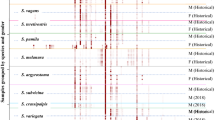Abstract
Major cuticular hydrocarbon components in several castes ofReticulitermes flavipes (Kollar) have been identified and quantitated. Types of hydrocarbons present includen-alkanes, 2-methylalkanes, 3-methylalkanes, 5-methylalkanes, an alkene, and an alkadiene, with a range in carbon numbers from C21 to C26, This is the first report on insect cuticular hydrocarbons in which both 2- and 3-methylalkanes are present, as well as the first report of an insect with a conjugated alkadiene.
Similar content being viewed by others
References
Abley, P., McQuillin, F.J., Minnikin, D.E., Kusamran, K., Maskens, K., Polgar, N. 1970. Location of olefinic links in long-chain esters by methoxymercuration-demercuration followed by gas chromatography-mass spectrometry.Chem. Commun. 1970:348–349.
Albro, P.W., andDittmer, J.C. 1970. Bacterial hydrocarbons: Occurrence, structure and metabolism.Lipids 5:320–325.
Beament, J.W.L. 1964. The active transport and passive movement of water in insects, pp. 67–129,in J.W.L. Beament, J.E. Treherne, and V.B. Wigglesworth (eds.). Advances in Insect Physiology, Vol. 2. Academic Press, New York.
Blailock, T.T., Blomquist, G.J., andJackson, L.L. 1976. Biosynthesis of 2-methylalkanes in the cricketsNemobius fasciatus andGryllus pennsylvanicus.Biochem. Biophys. Res. Commun. 68:841–849.
Blomquist, G.J., andKearney, G.P. 1976. Biosynthesis of internally branched mono-methylalkanes in the cockroachPeriplaneta fuliginosa.Arch. Biochem. Biophys. 173:546–553.
Blomquist, G.J., Major, M.A., andLok, J.B. 1975. Biosynthesis of 3-methylpentacosane in the cockroachPeriplaneta americana.Biochem. Biophys. Res. Commun. 64:43–50.
Blomquist, G.J., Blailock, T.T., Scheetz, R.W., andJackson, L.L. 1976. Cuticular lipids of insects—VII. Cuticular hydrocarbons of the cricketsAcheta domesticus, Gryllus pennsylvanicus, andNemobius fasciatus.Comp. Biochem. Physiol. 54B:381–386.
Bloodworth, A.J., Hutchings, M.G., andSotowicz, A.J. 1976. 1,4-Oxymercuration.J. Chem. Soc. D. 1976:578–579.
Blum, M.S. 1974. Pheromonal sociality in the Hymenoptera, pp. 222–249,in M.C. Birch (ed.). Pheromones. North Holland, Amsterdam.
Budzikiewicz, H., Djerassi, C, andWilliams, D.H. 1967. Mass Spectrometry of Organic Compounds. 690 pp. Holden-Day, San Francisco.
Collins, M.S. 1969. Water relations in termites, pp. 433–458,in K. Krishna and F.M. Weesner (eds.). Biology of Termites, Vol. 1. Academic Press, New York.
Hutchins, R.F., andMartin, M.M. 1968. The lipids of the common house cricket,Acheta domesticus L. II. Hydrocarbons.Lipids 3:250–255.
Inscoe, M.N., andBeroza, M. 1976. Insect-behavior chemicals active in field trials, pp. 145–181,in M. Beroza (ed.). ACS Symposium Series 23, Pest Management with Insect Sex Attractants. American Chemical Society, Washington, D.C.
Jackson, L.L., andBlomquist, G.J. 1976. Insect waxes, pp. 201–233,in P.E. Kolatukudy (ed.), Chemistry and Biochemistry of Natural Waxes. Elsevier, Amsterdam.
Jones, R.L., Lewis, W.J., Gross, H.R., Jr., andNordlund, D.A. 1976. Use of kairomones to promote action by beneficial insect parasites, pp. 119–134,in M. Beroza (ed.). ACS Symposium Series 23, Pest Management with Insect Sex Attractants. American Chemical Society, Washington, D.C.
Kolattukudy, P.E., andWalton, T.J. 1972. The biochemistry of plant cuticular lipids, pp. 119–175,in R.T. Holman (ed.). Progress in the Chemistry of Fats and Other Lipids, Vol. 13, Pt. 3. Pergamon Press, Elmsford, New York.
Miller, E.M. 1969. Caste differentiation in the lower termites, pp. 283–310,in K. Krishna and F.M. Weesner (eds.). Biology of Termites, Vol. 1. Academic Press, New York.
Moore, B.P. 1969. Biochemical studies in termites, pp. 407–432,in K. Krishna and F.M. Weesner (eds.). Biology of Termites, Vol. 1. Academic Press, New York.
Nakanishi, K. 1962. Infrared Absorption Spectroscopy—Practical. 233 pp. Holden-Day, San Francisco.
Neville, A.C. 1975. Biology of the Arthropod Cuticle, 2 vols, in one, Vols. 4–5. 448 pp. (Zoophysiology and Ecology Ser.). Springer-Verlag, New York.
O'Conner, J.G., Burow, F.H., andNorris, M.S. 1962. Determination of normal paraffins in C20 to C32 paraffin waxes by molecular sieve adsorption.Anal. Chem. 34:82–85.
Scott, A.I. 1964. Interpretation of the Ultraviolet Spectra of Natural Products. 433 pp. Pergamon Press, New York.
Author information
Authors and Affiliations
Rights and permissions
About this article
Cite this article
Howard, R.W., McDaniel, C.A. & Blomquist, G.J. Cuticular hydrocarbons of the eastern subterranean termite,Reticulitermes flavipes (Kollar) (Isoptera: Rhinotermitidae). J Chem Ecol 4, 233–245 (1978). https://doi.org/10.1007/BF00988058
Received:
Revised:
Issue Date:
DOI: https://doi.org/10.1007/BF00988058




